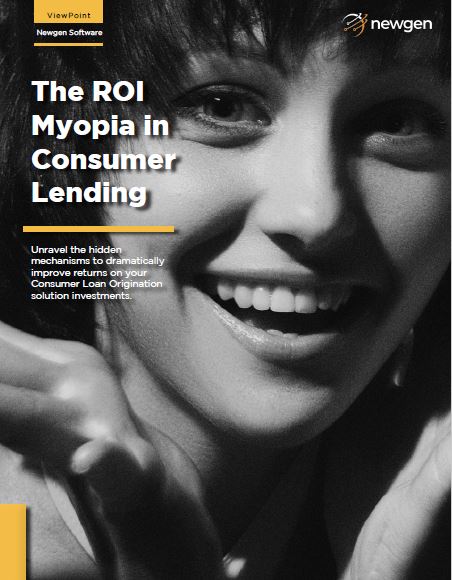Why Traditional ROI Models Are Failing Lenders?
Consumer lending is undergoing a fundamental digital transformation. What was once a straightforward 3-6-3 banking model (raise deposits at 3%, lend at 6%, and relax at 3 PM) has shifted to the 3-1-0 system popularized by digital lenders like Ant Financial 3 minutes to decide, 1 minute to transfer funds, and 0 human touch.
While digital lenders move at lightning speed, many banks and traditional lenders still measure the ROI of their Loan Origination Systems (LOS) through outdated, cost-centric metrics. These models focus narrowly on turnaround time (TAT), operational efficiency, and IT savings but fail to capture the true strategic value of modern lending platforms.
This whitepaper helps lenders go beyond ROI myopia and adopt a more comprehensive view that aligns with today’s digital-first, customer-centric environment.
Why Consumer Lending Needs a New ROI Perspective?
- Customer-first market: Borrowers have endless options; speed, personalization, and convenience drive loyalty.
- Technology as the growth engine: LOS is no longer just an enabler it’s the core business driver for revenue and risk management.
- Rising competition from fintechs: Agile, digital-native players offer seamless, fast lending experiences that disrupt traditional models.
- Legacy silos slowing innovation: Fragmented processes and outdated LOS prevent scaling new products and channels efficiently.
Simply put, LOS decisions today impact the entire lending business not just the back office.
The Shortcomings of Traditional ROI Models
Conventional ROI for LOS is built around:
- TAT reduction faster processing means more loans and higher gross interest income.
- Operational efficiency reduced manual effort, paper costs, and IT maintenance.
- Risk and compliance control fewer non-performing assets (NPAs) and better audit readiness.
While valuable, these metrics are too narrow. They ignore lost opportunities from poor customer experience, slow product launches, or rigid architectures that can’t support innovation.
A Holistic ROI Framework for Consumer Lending
To align LOS investments with growth and profitability, lenders should assess ROI across five dimensions:
1. Customer and Revenue Impact
- Wallet share expansion: Offer multiple loan products through unified platforms.
- Customer engagement: Omnichannel onboarding, easy opt-ins, and personalized journeys.
- NPS & CSAT improvement: Faster approvals, real-time updates, and transparency drive loyalty.
- Revenue per loan: Balance origination fees, interest, and cost of processing to optimize margins.
- Complaint and abandonment reduction: Smooth, low-friction applications reduce drop-offs and support costs.
2. Operational Efficiency
- Loan pull-through rate: Increase application-to-funding conversion with automation and better data capture.
- Cycle time reduction: Compete with fintech speed by cutting days to minutes using STP and RPA.
- First-time-right submissions: Automate data validation to minimize rework and manual corrections.
- Productivity uplift: Free knowledge workers (credit analysts, underwriters) from repetitive tasks with AI-driven workflows.
- Scalability: Process more loans without increasing headcount.
3. Risk & Compliance Strength
- Better credit decisions: AI-powered insights and comprehensive data reduce NPAs and fraud.
- Auditability: Digital documentation and rule-based workflows improve traceability and regulatory readiness.
- Early fraud detection: Predictive analytics and red-flag triggers reduce leakage and losses.
4. Agility and Innovation
- Faster product launches: Quickly roll out new loan types or adapt credit policies.
- Configurable workflows: Low-code tools enable continuous updates without heavy IT intervention.
- Channel expansion: Seamless mobile, social, and web integration supports modern borrower journeys.
5. Human Experience
- Empowered employees: Intuitive tools for underwriters and RMs reduce frustration and speed decision-making.
- Low-touch, self-service options: Let borrowers complete more of the journey independently while freeing staff.
- Seamless omnichannel touchpoints: Allow customers to move fluidly across devices and channels.
The ROI Equation Margin × Velocity
Renowned business strategist Ram Charan frames ROI simply:
ROI = Margin × Velocity
For lenders, this means:
- Margin drivers: Increased revenue per loan, cross-sell opportunities, lower losses, better risk control.
- Velocity drivers: Faster approvals, quicker product launches, and agile change management.
A modern LOS must maximize both to deliver sustainable business impact.
Business Impact of a Holistic ROI View
Lenders moving beyond ROI myopia report:
- 50–80% cycle time reduction through straight-through processing and automation.
- Higher loan pull-through and approval rates thanks to cleaner data and guided workflows.
- Up to 50% cost savings by eliminating rework and paper-heavy processes.
- Improved compliance and risk resilience with digital audit trails and advanced fraud detection.
- Stronger customer retention and revenue growth through faster, personalized lending experiences.
How Newgen Helps Lenders Reimagine ROI?
Newgen’s Consumer Loan Origination Solution offers:
- Low-code agility quickly adapt processes and policies to market or regulatory changes.
- End-to-end automation from prospecting and underwriting to disbursement and monitoring.
- AI & RPA intelligence smarter credit decisions and faster processing.
- Integrated content and document management single source of truth for compliance and collaboration.
- Future-ready scalability cloud, API-driven integrations, and modular expansion.
By aligning technology investments with holistic ROI, Newgen empowers lenders to transform from cost-centric to growth-driven organizations.
Why Acting Now Matters?
Fintech disruptors are redefining consumer lending speed and convenience. Traditional lenders risk losing market share, profitability, and customer trust by sticking to outdated ROI frameworks.
A modern, AI-first, low-code LOS can unlock speed, flexibility, and measurable returns across customer experience, operational efficiency, and risk management.
Begin Your ROI Transformation
If your ROI metrics stop at TAT and cost savings, it’s time to look deeper.

